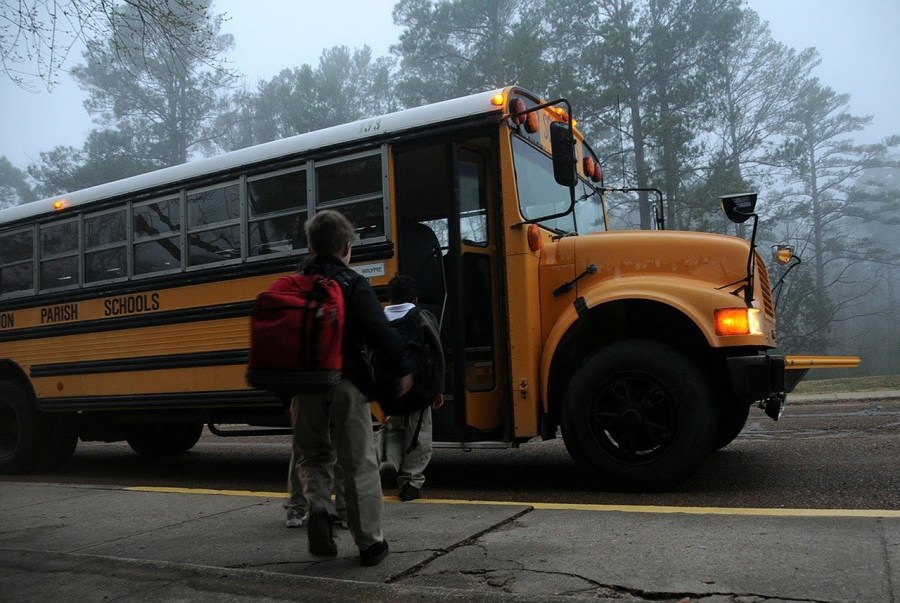Long School Bus Funny School Bus

Y'all meet them everywhere: those yellow school buses, taking kids to and from classes and field trips. They seem like big behemoths as they become down the route. In the The states, at that place are actually four different types of buses that schoolhouse systems can utilize, and federal regulations require that they be no longer than 45 anxiety.
Types of School Buses in the United States
At that place are four types of schoolhouse buses that meet safety standards and regulations in the Us. These buses are all unlike sizes and formats. A Type A bus is a smaller bus that is built on a van chassis only cutaway from a van size to have a higher capacity. These buses take a driver's side front door and a larger jitney entry door for passengers. Type B buses are pocket-sized but built upon a motorbus trunk. The entrance door for everyone is located on the front passenger side.
A Blazon C bus is called a "conventional" autobus. Information technology's congenital on a flat chassis and has an engine located at the front of the bus. These are the well-nigh common buses yous'll see on the road. Type D buses are the largest in performance, and they take an entry door at the front right side. The engine on these buses can be in the forepart or rear.
T he History of School Transportation
Transporting students to school dates dorsum to the 1880s; before that time, kids had to walk or find other means to get to school. In 1886, the Wayne Works company of Indiana developed wagons for school transportation. The company chosen these wagons "child hacks" or "school hacks."
Wagon ship to school didn't take off nationwide, but with the advent of the automobile, Wayne Works developed a motorized wagon in 1914. A. L. Luce, a Ford dealer in Georgia, developed the first motorized school bus in 1927, and he would later develop Bluish Bird Corporation, a leading manufacturer of school buses. Iii years later, Wayne Works adult a autobus of their own, and they would become another leading autobus builder.
Westward hy Are School Buses Yellowish?
One of the things anybody notices about schoolhouse buses is the distinct yellow colour. Why are school buses painted this color, and where did the idea come from? School motorcoach yellow dates back to 1939, when educator Frank Cyr revealed the results of his written report of school buses in ten states. Cyr discovered that various states had different types of buses, and some states were using trucks or horse-drawn wagons to transport kids to school.
Cyr proposed a national standard for schoolhouse buses for consistency beyond the lath. When some people at the conference suggested that the Usa pigment buses red, white, and blue, Cyr balked and studied the best color to get the attention of other vehicles. He placed l paint samples around a room and discovered that the xanthous color we now associate with school buses defenseless the eye better than any other colour. Federal police doesn't crave schoolhouse systems to pigment their buses the same color, so the yellow school buses are voluntary.
S afety Features
School buses have a specific design that ensures the rubber of everyone aboard. The concept of compartmentalization drives bus design, with the idea that passengers tin exist protected without seat belts, since seat belts aren't mandatory in the vast majority of school systems nationwide. The seats on school buses sit down high plenty that most opposing vehicles are below the feet of passengers. Heavily padded seats provide cushioning on impact, while aisle and rows of seats are close enough to each other that passengers don't move around much in the upshot of a crash.
Younger children sit down three to a seat and older kids and adults sit ii to a seat to prevent motility in a crash. Windows are higher on schoolhouse buses than on other vehicles, and there are no windshields about passengers. Finally, school buses have multiple emergency exits to go far easier for anyone to go out.
R educing Environmental Touch
For a long time, modern school buses have relied on diesel as their master fuel choice. Fifty-fifty as recently every bit 2017, over three fourths of school buses used diesel. That aforementioned year, gasoline-powered buses became more prevalent, simply they're still far in the minority. Alternative fuel school buses that run on natural gas are a much smaller piece of the pie, but they're bound to increment as schoolhouse systems look for more environmentally friendly technology. Electric school buses are expensive, but they tin be good solutions for urban school systems.
Source: https://www.reference.com/world-view/long-school-bus-feet-3c674c9adc10c1bd?utm_content=params%3Ao%3D740005%26ad%3DdirN%26qo%3DserpIndex